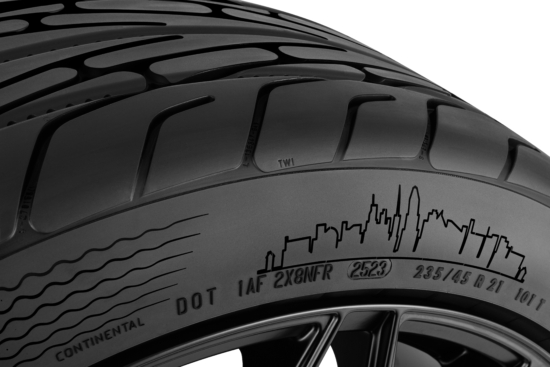IAA Mobility: Conti CityPlus Concept offers 10% energy efficiency increase
 (Photo: Continental)
(Photo: Continental)
Continental has unveiled its new Conti CityPlus concept at the IAA Mobility event. According to the Hanover-based tyremaker, this state-of-the-art tyre technology increases the total energy efficiency of a tyre by up to 10 per cent. The results are said to be “lower CO2 emissions from passenger cars with combustion engines and longer driving ranges for electric vehicles.” This was achieved by optimising the tyre behaviour during stop-and-go traffic in urban driving situations, increasing the range of passenger cars by up to 3 per cent as a result. This corresponds to a saving of 0.6 kWh per 100 kilometres for electric vehicles.
Continental has also been presenting “the most sustainable series tyre ever seen in the industry” at IAA Mobility: Continental’s UltraContact NXT. With up to 65 per cent renewable, recycled and ISCC PLUS mass balance certified materials, it has the highest share of sustainable materials ever seen in a production tyre. All of its 19 sizes were awarded the highest EU tyre label ratings for wet grip, pass-by noise and rolling resistance.
“We have set ourselves ambitious sustainability goals. At IAA we present the latest technological advances exemplifying our immense material competence. The Conti CityPlus technology reduces the total energy consumption of a tyre. We see great potential, especially for electric vehicles, where every kilometre of range counts,” said Klaus Kreipe, who heads up Continental Tires’ original equipment business in Europe, the Middle East and Africa (EMEA), adding: “The UltraContact NXT is the most sustainable series tyre to date. It combines a high proportion of sustainable materials with maximum safety and performance.”
According to Continental, the key to the massive gains is increasing efficiency while maintaining rolling resistance performance. Urban traffic is characterised by stop-start driving. This causes torsional deformation of the tyres in response to the applied torque, causing energy to dissipate in the process. The Conti CityPlus technology is designed to improve total energy efficiency under these kinds of driving conditions. That is said to be especially beneficial for electric vehicles because their higher torque and weight amplify energy loss in tyres:
“We believe that it is important to look at the energy efficiency of tyres as a whole. This includes free rolling as well as braking and acceleration. The result is up to 10 per cent greater energy efficiency with the same rolling resistance levels,” explained Kreipe.
Further range include: a specially designed tread pattern, newly constructed carcass, and modified rubber compound. The tread strip features a special V-shape pattern, which creates a stiffer pattern structure. In addition, a new construction method results in a stiffer carcass which reduces tyre deformation. The special system of fillers and an optimised polymer network in the rubber compound also contribute to the tyre’s high overall energy efficiency.
When developing energy-efficient tyres, tyre engineers and material experts have focused up until now on optimising a tyre’s rolling resistance during free rolling at a constant speed. This approach has enabled Continental to minimise the rolling resistance of the passenger car tyres in its portfolio in total by an average of 25 percent over the past decade.
By 2030, Continental aims to have over 40 per cent renewable and recycled content in its tyres. Continental is continuing its drive toward 100 per cent sustainable materials in all its tyre products by 2050 at the latest.
“The Conti CityPlus technology reduces the total energy consumption of a tyre. We see great potential, especially for electric vehicles, where every kilometre of range counts,” said Klaus Kreipe, Head of Continental Tires’ original equipment business in Europe, the Middle East and Africa (EMEA). (Photo: Continental)


 Scandinavian Enviro Systems
Scandinavian Enviro Systems

Comments